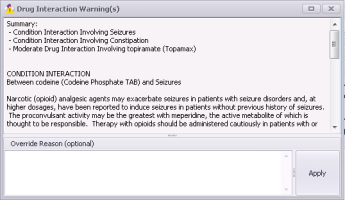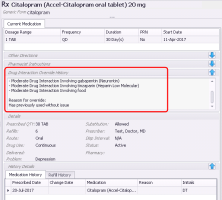Managing medication interaction warnings (new prescriber)
Note: This information applies to the new prescriber (see New prescriber).
When you prescribe or refill a medication, the EMR checks the medication against the Cerner Multum database for:
Drug-to-allergy interactions (with allergies and intolerances listed in the patient’s active allergies)
Drug-to-drug interactions (with drugs listed in the patient’s active medications list)
Drug-to-condition interactions (with conditions listed in the patient’s problems list)
Best practice: If a patient is no longer taking a medication, but the medication is listed in the patient’s Active Medications list, always discontinue the medication. This way, you will not receive interaction warnings against irrelevant medications.
Important: The EMR does not check for high or low dosages. For example, if you prescribe a medication dose that is too high for the patient’s weight or age, you are not notified.
If any interactions are found, you may be prompted with a pop-up warning. You can configure the EMR to not display pop-up warnings, and instead allow you to manually check for interaction warnings. You can also configure the EMR to not check for interactions at all. See Re-printing prescriptions (new prescriber).
When you receive an interaction warning, the EMR lists a summary of drug interactions and then provides full details about the interactions.
Steps
If no interactions are found, the message “No interactions found” appears.
| 2. | Using the following table, manage any interaction warnings. |
| To do this... | Complete the following steps... | ||||||||||||
|---|---|---|---|---|---|---|---|---|---|---|---|---|---|
|
Continue to prescribe the medication despite the warning(s) |
Perform one of the following actions: To record a reason for continuing with the prescription, in the Override Reason (optional) field, enter your reason, and then click Apply. If you do not want to enter an override reason, close the Drug Interaction Warning(s) window. You can now continue on with the prescription. |
||||||||||||
|
Prescribe an alternative medication |
|
||||||||||||
|
Discontinue the medication that interacts with the medication you are prescribing |
|
||||||||||||
|
Remove an allergy or intolerance from the patient’s Active Allergies list (for example, because the allergy or intolerance is unsupported, or was recorded in error) |
|
||||||||||||
|
Stop the prescription |
|
| 4. | If you entered and applied an override reason, but want to add another reason: |
| a) | At the top of the Medications and Allergies window, click Interactions |
| b) | In the Override Reason (optional) area, enter your reason, and then click Apply. |
| c) | Close the Drug Interaction Warning(s) window. |
After the prescription is saved. The EMR displays any interaction warnings along with your over ride reason(s) in the Current Medication detail tab for the medication. See Viewing patient medications (new prescriber).
© 2018 

